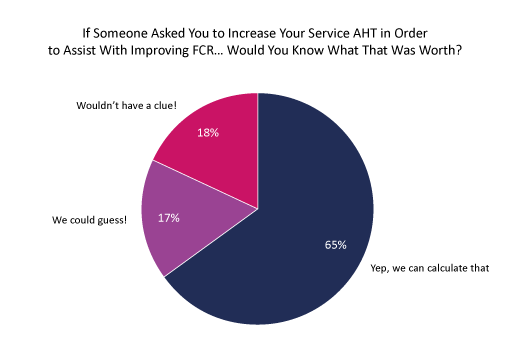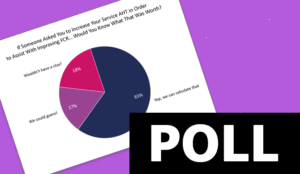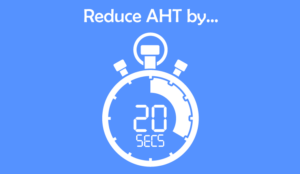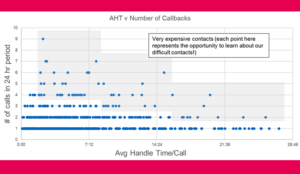Paul asked our LinkedIn Community:
‘So many people I talk to want to be able to build a business case for improving First Contact Resolution… but are struggling to get hold of the actual true repeat contact value.
If someone asked you to increase your service AHT in order to assist with improving FCR… would you know what that was worth?’
253 industry professionals responded to the poll, providing their insights and opinions.

| Ability to Measure | Response % |
|---|---|
| Yep, we can calculate that | 65% |
| We could guess! | 17% |
| Wouldn’t have a clue! | 18% |
Of the three options, 65% said they could calculate the value of increasing Average Handling Time (AHT) to improve First Contact Resolution (FCR).
With 18% saying they wouldn’t have a clue, and 17% saying they could guess, the results suggest that contact centres may not have the necessary skills and tools to make the most of their data.
Alternatively, as 35% responded that they either couldn’t calculate it or could guess, the results could suggest that contact centres are not necessarily interested in working out this figure.
There were also some interesting comments, which add more information and insight into the poll results and improving FCR:
Training
Keyword: Training, it’s the most important thing!
Thanks to Carol
Call Quality Evaluations
Improving FCR can be embedded in call quality evaluations. The team leader evaluated the call and systems actions and can gauge from both the information provided and actions taken whether the customer is likely to call back.
For instance, summarizing the call and actions taken ensures the customer is aware and if there are any additional points that may have been missed then it can be solved on the same call.
This will improve CSAT and FCR.
Thanks to Barton S.
Identify Themes, Topics, or Events in Each Conversation
Agreed, but then you can only realistically do that on 1-2% of a random pot of calls – something most businesses always struggle with.
I think the key to this is being able to identify themes and topics or events in each conversation to allow both Auto-QA to an extent (and allow the humans to get back to FCR coaching etc, rather than ticking boxes on ID&V for example) and also getting the QA teams and coaches to the pots of calls that are of most interest to them – i.e. looking at complaints calls specifically, where ‘website issues’ were discussed.
You could argue that agents disposition calls, but then they only ever disposition on the overarching topic the customer called about, not the subsequent things that were discussed further on in that conversation.
Thanks to Paul
Will Increasing FCR Add Value or Improve CX?
Is your business one where increasing FCR will add value or improve customer experience? Can you utilize self-service to drive FCR on some/all questions?
AHT has never been a meaningful measure of, or an input into improving customer satisfaction. It is purely a business cost measure.
My experience is that any direct focus on AHT as a driver of customer experience will give rise to unintended negative consequences.
Thanks to Doug L.
Is FCR Genuine or Ticking a Box
Largely depends on whether you intend on ‘genuinely’ solving the customer’s query in one (presuming that’s possible), or whether the business is ‘ticking a box’ to say they solved it, but not really getting to the bottom of the actual query.
I didn’t imply in the question that it was driving a need to improve customer satisfaction, not sure where that came from?
Agree, CSAT must be important to a business, but they also have a duty to prevent inefficient and margin-sucking activities, so FCR will always be important to a business.
I think your last point is interesting in that you’ve never seen a focus on FCR drive better CSAT due to unintended consequences – I think many businesses suffer from this in trying to deal with many metrics.
It’s one of the reasons I find customer conversation analytics to be fascinating – because you can tweak something like FCR and measure the CX outputs immediately, rather than waiting for an aggregated view 6 months down the line to tell you it was right/wrong or even how badly it affected CX?
Thanks to Paul
AHT Doesn’t Have a Direct Impact on FCR
AHT doesn’t have a direct impact on FCR. There are multiple factors that play a big part. We have at the first contact, what happens thereafter and if there was an actual resolution that was within one’s control.
Thanks to Inbanathan
We Focus on Customer-Centred Metrics
We stopped putting a large focus on AHT because agents became more focused on that than actually providing a service.
FCR is still monitored for us because on average our emails take 2.5 touches but calls and chats should take 1-1.5 due to the nature of our business and needing photos to go along with the conversation. So now we look more at CSAT, NPS scores, company reviews.
We moved away from a lot of the traditional call centre metrics and are focusing more on customer-centred metrics.
We still use those metrics to identify forecasting, scheduling, budgets, etc. but we don’t put a big emphasis on it with our agents in their productivity.
Thanks to Jackie
Many Independent Variables That Change FCR Performance
An increase in AHT will not directly impact FCR. There is correlation, but there are many independent variables that change FCR performance outcomes. FCR can be improved by many avenues, but usually more specific to your business.
There are technology tools for agents to help them find an answer faster, IVR changes to determine if the caller is calling on a previous matter, with information gathering prior to agent connection, agent training to improve knowledge of contact interactions, skills assignment and proficiency realignment, etc. Just a few ideas.
Thanks to Paul
Either FCR Can Be Achieved, or It Cannot
Food for thought, Paul Banks, either FCR can be achieved, or it cannot. If not, then there are other issues to address first, or maybe it’s just not practical in some businesses.
Not sure how increasing AHT would be helpful!
Thanks to Karen
Not a Direct Correlation
It’s an interesting conundrum, and really was more about whether people can quantify it to build a business case in the example above.
There is a correlation between AHT and FCR, albeit not necessarily a direct one, but for definite, if agents are worrying about their handling times as opposed to completing all the necessary workflows or asking the right questions to get to the bottom of the actual reason for contact (not always what the customer identifies), then you’re never going to hit FCR.
It also depends on what you’re classing as FCR, if you’re working in an industry where multiple contacts are required for resolution (technical support, for example), but then in that case, it’s a different question entirely.
Thanks to Paul
Fitting a Square Peg in a Round Hole
Sounds to me, Paul, some KPIs or benchmarks are like fitting a square peg in a round hole. There are so many ramifications for this one!
Understand your working out for the correlation between AHT and FCR. However, my business case for improving FCR would be to find out a) is it possible? b) what’s stopping us achieving it? c) is it important to our customer we achieve it?
Sounds to me if an advisor is not achieving FCR because they are worried about AHT so taking shortcuts! then most definitely AHT needs to be looked at alongside the processes, workflows and knowledge bases.
If that is the scenario then the worth to the business to put it right in cost would be minimal, whilst damage to reputation high cost and high risk.
Thanks to Karen
Other Things to Consider
Plenty of other things to consider, not only increasing AHT also FCR is not impacted directly by AHT, is driven also by the quality of the call, the quality of the training received and good customer service….
Thanks to Emil
AHT Is an Outcome Not a Target on Its Own
So that makes AHT an outcome that you need to calculate to forecast costs, staffing service levels etc, but which can’t be a target on its own
Thanks to Nick
You Can’t Improve What You Don’t Measure
You can’t improve what you don’t measure.
But the measured metrics have to be taken for what they are and acknowledged as indicators of other issues and problems.
Any business that relies heavily on humans will always have complex root cause analysis.
That being said, I do think we over-complicate people and their motivations!
Thanks to Paul
Appropriate Handling Time for Each Issue
We should also remember the importance of measuring the Appropriate Handling Time for each issue, in place of an average to ensure you can use positive outcome language when talking to the team about improving customer outcomes.
No customer I’ve met ever thinks of contacting a business for an average outcome
Thanks to Jason
Analytics Combined With Behavioural Science Principles
Jason Roberts nailed it. I wish more businesses considered analytics combined with behavioural science principles!
We’ve been talking to a partner about how we help their agents each get dynamic targets based on the complexity of the conversations they’ve experienced… Now that would be amazing to see in action!
Thanks to Paul
Source: Poll conducted in our LinkedIn Community Sample size – 253 Date: 2022
Author: Robyn Coppell
Published On: 3rd Nov 2022
Read more about - Contact Centre Research, Average Handling Time (AHT), First Contact Resolution (FCR), Polls



































